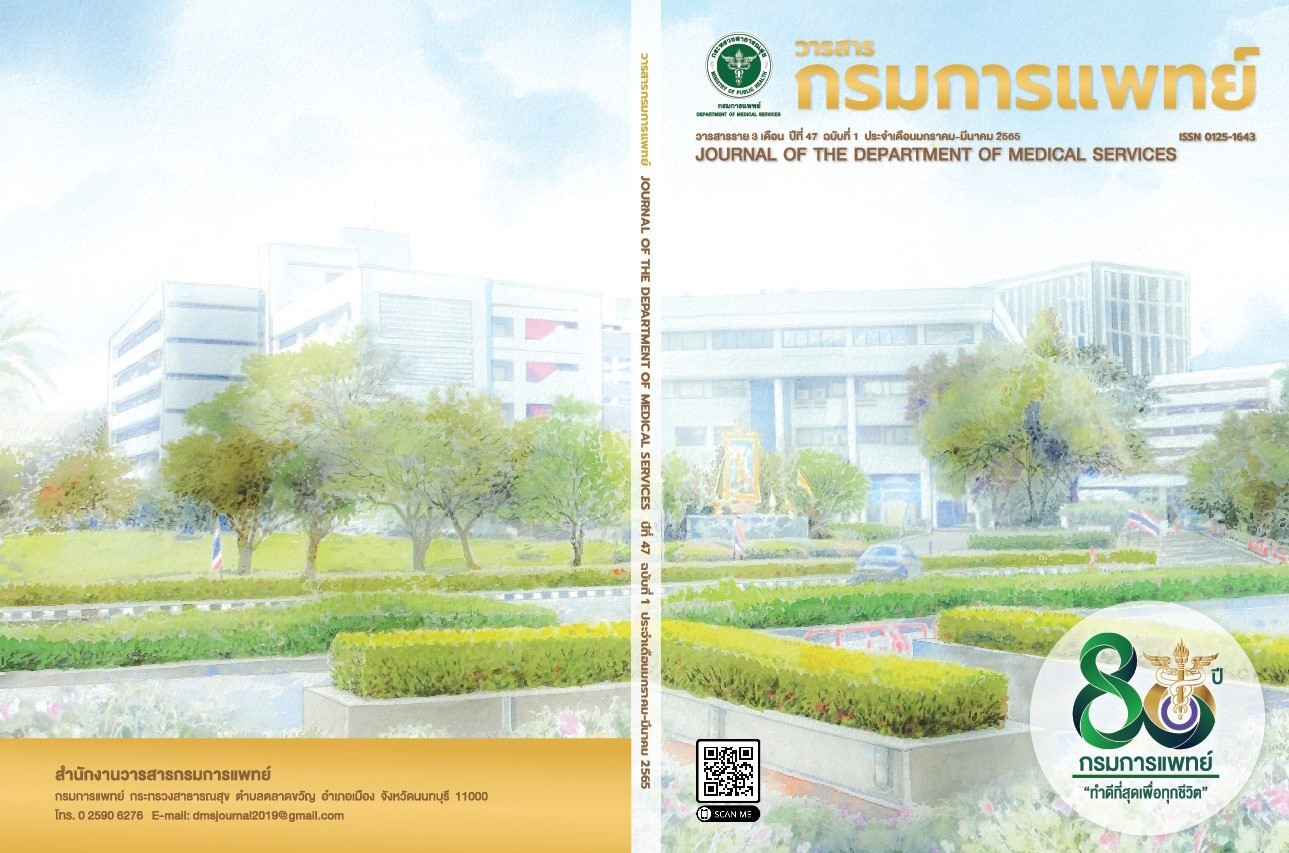Incidence of inborn error of metabolism from newborn screening with Tandem mass spectrometry
Keywords:
Inborn error of metabolism, incidence, newborn screening, rare diseasesAbstract
Background: Inborn error of metabolism, from newborn screening with Tandem mass spectrometry, is a group of diseases due to abnormal metabolism of amino acids and fatty acids. These are autosomal recessive genetic disorders which are rare diseases. The incidence of these disorders in the worldwide ranges from 1 in 3,000 - 10,000.Objective: To determine the incidence of inborn error of metabolism from newborn screening with Tandem mass spectrometry in Thai population.Methods: A retrospective study by reviewing data from newborn screening at the laboratory in Queen Sirikit National Institute of Child Health in the year 2020 were done. Results: The total number of children who had the newborn screening done during ten months was 15,421. There were two children with the abnormal test. After confirmation tests, one child was diagnosed with primary carnitine deficiency, and the other child was diagnosed with maternal 3-methylcrotonyl-coenzyme A carboxylase deficiency. The incidence of inborn error of metabolism from this study was 1:15,421.Conclusion: The incidence of inborn error of metabolism from this study is lower than other studies. Further study in larger population is needed to determine the accurate incidence of Thai population.
References
Ma S, Guo Q, Zhang Z, He Z, Yue A, Song Z, et al. Expandednewborn screening for inborn errors of metabolism by tandem mass spectrometry in newborns from Xinxiang city in China. J Clin Lab Anal. 2020; 34(5):e23159.
Wilcken B, Wiley V, Hammond J, Carpenter K. Screening newborns for inborn errors of metabolism by tandem mass spectrometry. N Engl J Med. 2003; 348(23):2304-12.
Feuchtbaum L, Lorey F, Faulkner L, Sherwin J, Currier R, Bhandal A, Cunningham G. California’s experience implementing a pilot newborn supplemental screening program using tandem mass spectrometry. Pediatrics. 2006; 117(5 Pt 2):S261-9.
Liammongkolkul S., Sanomcham K., Vatanavicharn N., Sathienkijkanchai A, Ranieri E., Wasant P Expandednewborn screening program in Thailand. Ann Transl Med. 2017; 5(Suppl 2): AB133.
Ramaswamy M, Anthony Skrinska V, Fayez Mitri R, Abdoh G. Diagnosis of Carnitine Deficiency in Extremely Preterm Neonates Related to Parenteral Nutrition: Two Step Newborn Screening Approach. Int J Neonatal Screen. 2019; 5(3):29.
Newborn Screening Guide for Hospitals January 2021 Michigan Department of Health and Human services.
Chace DH, De Jesús VR, Lim TH, Hannon WH, Clark RH, Spitzer AR. Detection of TPN contamination of dried blood spots used in newborn and metabolic screening and its impact on quantitative measurement of amino acids. Clin Chim Acta. 2011; 412(15-16):1385-90.
Wiwanitkit V. Neonatal screening for hypothyroidism in Thailand: A summary. Endocrinologist 2006;16:255-6
Kuptanon C., Sawasdivorn S., Kabchan P. Congenital Hypothyroidism from Newborn Screening in Thailand Hsri-journal 2018; 2(3):452-455
Pangkanon S, Charoensiriwatana W, Janejai N, BoonwanichW, Chaisomchit S. Detection of phenylketonuria by the newborn screening program in Thailand. Southeast Asian J Trop Med Public Health. 2009; 40(3):525-9.
Mandel SJ, Hermos RJ, Larson CA, Prigozhin AB, Rojas DA, Mitchell ML. Atypical hypothyroidism and the very low birthweight infant. Thyroid.2000; 10:693–5.
Lee SH, Hong YH. Asymptomatic maternal 3-methyl-crotonylglycinuria detected by her unaffected baby’sneonatal screening test. Korean J Pediatr. 2014; 57(7):329-32.
El-Hattab AW, Li FY, Shen J, Powell BR, Bawle EV, Adams DJ, et al. Maternal systemic primary carnitine deficiency uncovered by newborn screening: clinical, biochemical, and molecular aspects. Genet Med. 2010; 12(1):19-24.
Yahyaoui R, Blasco-Alonso J, Gonzalo-Marín M, Benito C, Serrano-Nieto J, González-Gallego I, et al. Metabolic Serendipities of Expanded Newborn Screening. Genes (Basel). 2020; 11(9):1018.
Downloads
Published
How to Cite
Issue
Section
License
Copyright (c) 2022 Department of Medical Services, Ministry of Public Health

This work is licensed under a Creative Commons Attribution-NonCommercial-NoDerivatives 4.0 International License.
บทความที่ได้รับการตีพิมพ์เป็นลิขสิทธิ์ของกรมการแพทย์ กระทรวงสาธารณสุข
ข้อความและข้อคิดเห็นต่างๆ เป็นของผู้เขียนบทความ ไม่ใช่ความเห็นของกองบรรณาธิการหรือของวารสารกรมการแพทย์



